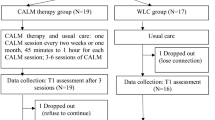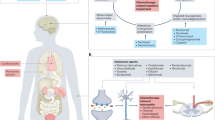Abstract
We investigated the hypothesis that global single-item quality-of-life indicators are less precise for specific treatment effects (discriminant validity) than multi-item scales but similarly efficient for overall treatment comparisons and changes over time (responsiveness) because they reflect the summation of the individual meaning and importance of various factors. Linear analogue self-assessment (LASA) indicators for physical well-being, mood and coping were compared with the Hospital Anxiety and Depression Scale (HAD), the Mood Adjective Check List (MACL) and the emotional behaviour and social interaction scales of the Sickness Impact Profile (SIP) in 84 patients with early breast cancer receiving adjuvant therapy. Discriminant validity was investigated by multitrait-multimethod correlation, responsiveness by standardized response mean (SRM). Discriminant validity of the indicators was present at baseline but less under treatment. Responsiveness was demonstrated by the expected pattern among treatments (P = 0.008). In patients without chemotherapy, the SRMs indicated moderate (0.5–0.8) to large (>0.8) improvements in physical well-being (0.70), coping (0.92), HAD anxiety (0.89) and depression (1.19), and MACL mental well-being (0.68). In patients with chemotherapy for the first 3 months, small but clinically significant improvements (>).2) included mood (0.38), coping (0.41), HAD axiety (0.31) and MACL mental well-being (0.35). Patients with 6 months chemotherapy showed no changes. The indicators also reflected mood disorders (HAD) and marked psychosocial dysfunction (SIP) at baseline and under treatment according to pre-defined cut-off levels. Global indicators were confirmed to be efficient for evaluating treatments overall and changes over time. The lower reliability of single as opposed to multi-item scales affects primarily their discriminant validity. This is less decisive in large sample sizes. © 2001 Cancer Research Campaign http://www.bjcancer.com
Similar content being viewed by others
Article PDF
Change history
16 November 2011
This paper was modified 12 months after initial publication to switch to Creative Commons licence terms, as noted at publication
References
Ahlmén EM, Bengtsson CB, Sullivan BM and Bjelle A (1990) A comparison of overall health between patients with rheumatoid arthritis and a population with and without rheumatoid arthritis. Scand J Rheumatol 19: 413–421
Augustinsson LE, Sullivan L and Sullivan M (1989) Chronic pain in functional neurosurgery: Function and mood in various diagnostic groups with reference to epidural spinal electrical stimulation. Schmerz/Pain/Douleur 10: 30–40
Bergner M, Bobbit RA, Carter WB and Gilson BS (1981) The Sickness Impact Profile: development and final revision of a health status measure. Med Care 19: 787–805
Bernhard J, Hürny C, Coates AS, Peterson HF, Castiglione Gertsch M, Gelber RD, Goldhirsch A, Senn HJ and Rudenstam CM (1997) Quality of life assessment in patients receiving adjuvant therapy for breast cancer: the IBCSG approach. The International Breast Cancer Study Group. Ann Oncol 8: 825–835
Bernhard J, Castiglione Gertsch M, Schmitz SF, Thürlimann B, Cavalli F, Morant R, Fey MF, Bonnefoi H, Goldhirsch A and Hürny C (1999a) Quality of life in postmenopausal patients with breast cancer after failure of tamoxifen: formestane versus megestrol acetate as second-line hormonal treatment. Swiss Group for Clinical Cancer Research (Sakk). Eur J Cancer 35: 913–920
Bernhard J, Thürlimann B, Schmitz SF, Castiglione Gertsch M, Cavalli F, Morant R, Fey MF, Bonnefoi H, Goldhirsch A and Hürny C (1999b) Defining clinical benefit in postmenopausal patients with breast cancer under second-line endocrine treatment: does quality of life matter? J Clin Oncol 17: 1672–1679
Butow P, Coates A, Dunn S, Bernhard J and Hürny C (1991) On the receiving end IV: Validation of quality of life indicators. Ann Oncol 2: 597–603
Coates A, Gebski V, Bishop JF, Jeal PN, Woods RL and Snyder R (1987) Improving the quality of life during chemotherapy for advanced breast cancer. A comparison of intermittent and continuous treatment strategies. N Engl J Med 317: 1490–1495
Coates A, Glasziou P and McNeil D (1990) On the receiving end – III. Measurement of quality of life during cancer chemotherapy. Ann Oncol 1: 213–217
Coates A, Gebski V, Signorini D, Murray P and McNeil D (1992) Prognostic value of quality-of-life scores during chemotherapy for advanced breast cancer. J Clin Oncol 10: 1833–1838
Coates A, Thomson D, McLeod GR, Hersey P, Gill PG, Olver IN, Kefford R, Lowenthal RM Beadle G and Walpole E (1993) Prognostic value of quality of life scores in a trial of chemotherapy with or without interferon in patients with metastatic malignant melanoma. Eur J Cancer 29A: 1731–1734
Cohen J (1977). Statistical power analysis for the behavioral sciences, Academic Press: New York
Cunny KA and Perri M (1991) Single-item vs multiple-item measures of health-related quality of life. Psychological Reports 69: 127–130
Fallowfield LJ, Hall A and Maguire GP MB (1990) Psychological outcomes of different treatment policies in women with early breast cancer outside a clinical trial. Br Med J 301: 575–580
Hall A, A'Hern R and Fallowfield L (1999) Are we using appropriate self-report questionnaires for detecting anxiety and depression in women with early breast cancer? Eur J Cancer 35: 79–85
Hürny C, Bernhard J, Gelber RD, Coates A, Castiglione M, Isley M, Dreher D, Peterson H, Goldhirsch A and Senn HJ (1992) Quality of life measures for patients receiving adjuvant therapy for breast cancer: an international trial. The International Breast Cancer Study Group. Eur J Cancer 28: 118–124
Hürny C, Bernhard J, Bacchi M, van Wegberg B, Tomamichel M, Spek U, Coates A, Castiglione M and Goldhirsch A (1993) The Perceived Adjustment to Chronic Illness Scale (PACIS): a global indicator of coping for operable breast cancer patients in clinical trials. Swiss Group for Clinical Cancer Research (SAKK) and the International Breast Cancer Study Group (IBCSG). Support Care Cancer 1: 200–208
Hürny C, Bernhard J, Coates A, Peterson HF, Castiglione-Gertsch M, Gelber RD, Rudenstam CM, Collins J, Lindtner J, Goldhirsch A and Senn HJ (1996a) Responsiveness of a single-item indicator versus a multi-item scale: assessment of emotional well-being in an international adjuvant breast cancer trial. Med Care 34: 234–248
Hürny C, Bernhard J, Coates AS, Castiglione Gertsch M, Peterson HF, Gelber RD, Forbes JF, Rudenstam CM, Simoncini E, Crivellari D, Goldhirsch A and Senn HJ (1996b) Impact of adjuvant therapy on quality of life in women with node-positive operable breast cancer. International Breast Cancer Study Group. Lancet 347: 1279–1284
Katz JN, Larson MG, Phillips CB, Fossel AH and Liang MH (1992) Comparative measurement sensitivity of short and longer health status instruments. Med Care 30: 917–925
Liang MH, Fossel AH and Larson MG (1990) Comparisons of five health status instruments for orthopedic evaluation. Med Care 28: 632–642
Manne SL, Sabbioni M, Bovbjerg DH, Jacobsen PB, Taylor KL and Redd WH (1994) Coping with chemotherapy for breast cancer. J Behav Med 17: 41–55
Maraste R, Brandt L, Olsson H and Ryde Brandt B (1992) Anxiety and depression in breast cancer patients at start of adjuvant radiotherapy. Relations to age and type of surgery. Acta Oncol 31: 641–643
Maunsell E, Brisson J and Deschênes L (1992) Psychological distress after initial treatment of breast cancer. Cancer 70: 120–125
Maunsell E, Brisson J, Deschenes L and Frasure Smith N (1996) Randomized trial of a psychologic distress screening program after breast cancer: effects on quality of life. J Clin Oncol 14: 2747–2755
McCormack HM de L Horne DJ and Sheather S (1988) Clinical applications of visual analogue scales: a critical review. Psych Med 18: 1007–1019
McHorney CA, Ware JE and Rogers WH (1992) The validity and relative precision of MOS Short- and Long-Form Health Status Scales and Dartmouth COOP charts: Results from the medical outcomes study. Med Care 30: MS253–MS265
Priestman TJ and Baum M (1976) Evaluation of quality of life in patients receiving treatment for advanced breast cancer. Lancet i: 899–900
Sjöberg L, Svensson E and Persson LO (1979) The measurement of mood. Scand J Psychol 20: 1–18
Sullivan BM, Ahlmén M, Archenholtz B and Svensson G (1986) Measuring health in rheumatic disorders by means of a Swedish version of the sickness impact profile. Scand J Rheumatol 15: 193–200
Sullivan M, Karlsson J, Sjöström L, Backman L, Bengtsson C, Bouchard C, Dahlgren S, Jonsson E, Larsson B, Lindstedt S, Näslund I, Olbe L and Wedel H (1993) Swedish obese subjects (SOS) – an intervention study of obesity. Baseline evaluation of health and psychosocial functioning in the first 1743 subjects examined. Int J Obes 17: 503–512
Ware JE, Snow KK, Kosinski M and Gandek B (1993). SF-36 Health Survey. Manual and interpretation guide, The Health Institute, New England Medical Center: Boston
Watson D and Pennebaker JW (1989) Health complaints, stress, and distress: Exploring the central role of negative affectivity. Psychol Rev 96: 234–254
Watson M, Greer S, Rowden L, Gorman C, Robertson B, Bliss JM and Tunmore R (1991) Relationships between emotional control, adjustment to cancer and depression and anxiety in breast cancer patients. Psychol Med 21: 51–57
Zerssen Dv (1986) Clinical self-rating scales (CSRS) of the Munich Psychiatric Information System (PSYCHIS München). Assessment of depression, Sartorius N, Ban TA (eds). 270–303, Springer: Berlin
Zigmond AS and Snaith RP (1983) The Hospital Anxiety and Depression Scale. Acta Psychiatrica Scand 67: 362–370
Author information
Authors and Affiliations
Rights and permissions
From twelve months after its original publication, this work is licensed under the Creative Commons Attribution-NonCommercial-Share Alike 3.0 Unported License. To view a copy of this license, visit http://creativecommons.org/licenses/by-nc-sa/3.0/
About this article
Cite this article
Bernhard, J., Sullivan, M., Hürny, C. et al. Clinical relevance of single item quality of life indicators in cancer clinical trials. Br J Cancer 84, 1156–1165 (2001). https://doi.org/10.1054/bjoc.2001.1785
Received:
Revised:
Accepted:
Published:
Issue date:
DOI: https://doi.org/10.1054/bjoc.2001.1785
Keywords
This article is cited by
-
Effects of financial empowerment and self-confidence in financial empowerment on financial well-being
Current Psychology (2023)
-
Quality of life of patients with rare cancer: a comparison with patients with colorectal cancer and the association with disease trajectory-related factors
Journal of Cancer Survivorship (2023)
-
Treatment-induced symptoms, depression and age as predictors of sexual problems in premenopausal women with early breast cancer receiving adjuvant endocrine therapy
Breast Cancer Research and Treatment (2020)
-
Quality of life under extended continuous versus intermittent adjuvant letrozole in lymph node-positive, early breast cancer patients: the SOLE randomised phase 3 trial
British Journal of Cancer (2019)
-
When do patient reported quality of life indicators become prognostic in breast cancer?
Health and Quality of Life Outcomes (2018)



